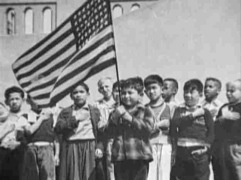Regarding, Romney’s speech to the NAACP on Tuesday, Nancy Pelosi told Bloomberg Television, “It was a calculated move on his part to get booed at the NAACP convention.”
She wasn’t the only one to see it that way. Many pundits have by now made this assertion as well. It’s hardly a tinfoil hat theory, but rather stating the obvious.
Breaking it down for the more gullible, here’s the scam:
Romney knows he’s not going to get more than the smallest fraction of the black vote. Yet, going to the NAACP, the nation’s oldest, and most respected civil rights organization, is what one is expected to do. So how do you make it pay?
You use it to excite the base. That’s Rovian politics and the Southern strategy.
Romney stood up and said what he “believes” in, showing the right-wing of his party he’s not afraid to say something that won’t be popular (to people who wouldn’t vote for him anyway). But beyond that, referencing the Affordable Healthcare Act in particular was important.
Since the Supreme Court ruled that mandates are constitutional, the popularity of health care reform has risen. The more people learn about what’s in the Act, the more they like it. Immediately after the ruling, Republicans tried to portray mandates as a “tax” on the middle-class. But that’s a hard sell. Most voters already have some form of health insurance and won’t be subject to mandates. Those who are ineligible for Medicare, Medicaid or employer health insurance welcome the low-cost options which the Act will bring them. Everyone is excited by the idea that they won’t be dropped because of pre-existing conditions, face “caps” on needed services, or have to drop their children when they turn eighteen.
The Affordable Healthcare Act is the biggest legislative success of Obama’s first term. As the Act becomes more popular, so does Obama. Making his biggest success into a liability is necessary. One way to do it is through a strong visual showing a group of prominent black people booing Romney for deriding “Obamacare.” The term itself implies not an act of Congress, reflecting the will of the American people, but rather something imposed on them by a usurper (and one with a funny “foreign” name). Adding the audio-visual of a group of NAACP members booing Romney for being against “Obamacare” reinforces the message that this government “giveaway” will take something away from hard working whites, something that black people want. It portrays Romney as standing up for the beleaguered white taxpayer who is sick of supporting “entitlement programs.” It references Reagan’s “welfare queens” as well as his challenging Gorbachev to tear down the wall.
That the Affordable Healthcare Act is so misunderstood may seem truly shocking to people who live in countries like England or Canada (or most of the developed world for that matter) where health care is understood to be a basic human right. However, the idea that this legislation was a threat to “ordinary” Americans has been a major part of the strategy against it and has been exploited ruthlessly, with false claims that it would lead to taking away Medicare, the very successful single-payer system of health insurance for elderly Americans.
The NAACP gig offered Romney a chance to face down a group (the blacks) and show white southerners and teabaggers that he was one of them, despite his elitist background, magical underwear and flip-flops on issues most near and dear to them.
In case he didn’t rile the NAACP crowd enough with his reference to Obamacare, he also managed to say other things designed to not exactly endear him. He specifically referenced his defense of “traditional marriage.” While much has been made of the opposition to gay rights by some black churches, the NAACP has come out strongly for marriage equality, and then there was his reference to his “kitchen cabinet” in Massachusetts which included African Americans. The mostly older crowd he addressed remember too well the history of blacks in the kitchen, and of white politicians meeting with black leaders on the down-low.
More evidence that this was staged came when it was spin time. At a fundraiser later that same day, Romney quipped, “. . . if they want more stuff from government tell them to go vote for the other guy — more free stuff.” This is a line that he’s used before when talking about contraception as part of health care and even student loan reforms. While the Republicans scream class warfare whenever the conversation turns to ending the millionaire tax cuts started by President Bush, they never miss an opportunity to imply that cuts to program that benefit the majority of Americans — healthcare, student loans, education, even essential services, are necessary, and anyone who implies differently is looking for a “giveaway” or “free stuff.” Deregulation of corporations (which are “people too, my friend”) and tax breaks for the ultra-rich must be retained at all costs if we are to be truly “free.”
Will this strategy work to defeat Obama? The scary thing is maybe it only has to come close. Coupled with a massive effort to disenfranchise likely democratic voters in swing states, and unlimited campaign spending, Romney has a good shot at winning, no matter what the polls say. And that’s without even taking into account the possibility of actual fraud via faulty recording by electronic voting machines that leave no paper trail. While a Romney “victory” might look suspicious if the polls show a 10-point Obama lead, they won’t if it’s close. In a land of paperless ballots, close may be good enough.
